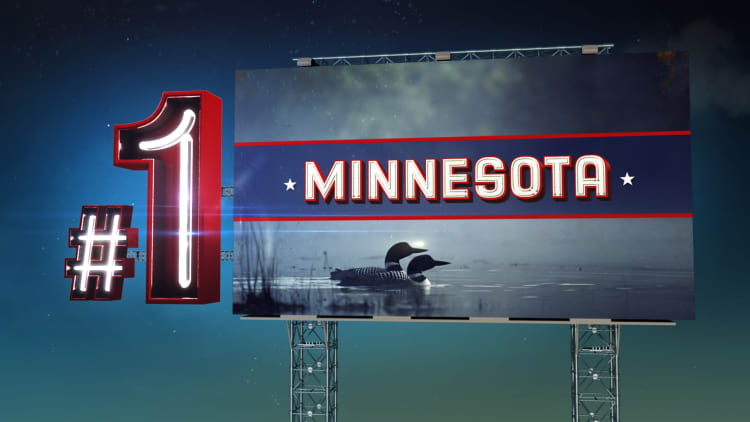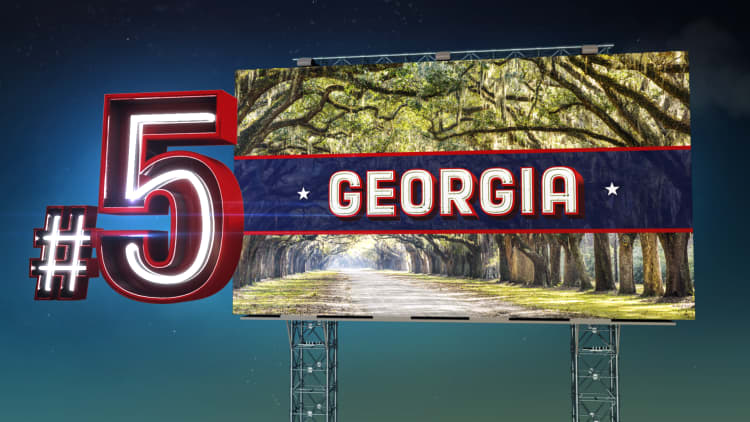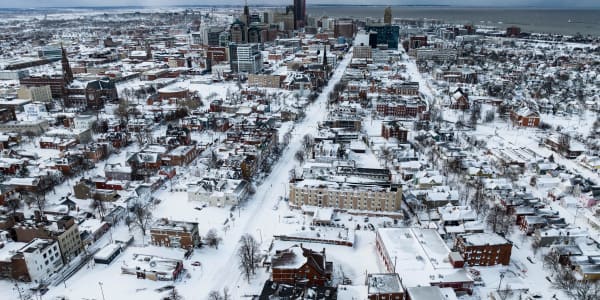
Leave it to the North Star State to chart a new course to competitiveness.
Minnesota is America's Top State for Business in 2015, reaching the pinnacle of success by way of a much different route than our eight previous winners.
Minnesota scores 1,584 out of a possible 2,500 points, ranking in the top half for all but two of our 10 categories of competitiveness. But what may be most instructive are the categories where Minnesota does not do well. Both involve cost. Indeed, the birthplace of Spam, Scotch Tape and the supercomputer marks a new first this year. Never since we began rating the states in 2007 has a high-tax, high-wage, union-friendly state made it to the top of our rankings. But Minnesota does so well in so many other areas—like education and quality of life—that its cost disadvantages fade away.
As always, we scored all 50 states in more than 60 metrics in 10 broad categories of competitiveness. You can read more about our methodology here.
This year's categories and point values are:
- Workforce (400 points)
- Cost of Doing Business (350 points)
- Infrastructure (350 points)
- Economy (340 points)
- Quality of Life (325 points)
- Technology & Innovation (250 points)
- Education (200 points)
- Business Friendliness (160 points)
- Cost of Living (75 points)
- Access to Capital (50 points)
To some degree, Minnesota benefits from a trend that we have sought to reflect in our study this year. Rather than just seeking the lowest taxes or the highest incentives, companies are increasingly chasing the largest supply of skilled, qualified workers. So states are touting their workforces like never before, giving the Workforce category—where Minnesota finishes a respectable 13th—greater weight in our study.
Read MoreGuess who's spending billions for jobs
But Minnesota doesn't just stumble into the top spot by accident. The state's path to the top is marked by a carefully crafted and still controversial strategy by Gov. Mark Dayton, the first Democrat to hold the office in two decades. The hallmark of his plan is something most governors seeking to win the hearts of business would never dream of: a big tax increase.
Dayton began calling for higher taxes almost as soon as he took office at the start of 2011, with the state facing a $6.2 billion budget gap. But his first attempt resulted in a standoff and a devastating three-week government shutdown. By 2013 he managed to push through a whopping $2.1 billion tax increase, primarily targeting smokers and wealthy people (one of whom is Dayton himself, an heir to the Target retail fortune). Last year Dayton did approve a $508 million middle-class tax cut. But the rate for top earners remains among the highest in the nation, at 9.85 percent.
This year, with a state budget surplus of nearly $2 billion, one of the lowest unemployment rates in the nation and apparently no exodus of millionaires, Dayton has been taking a victory lap of sorts. In his State of the State address in April, he said the improvement in state finances had laid the groundwork for solid economic growth.
Read MoreSupreme Court could blow up Obamacare for millions
"More Minnesota businesses are expanding, so more Minnesotans are working. They are earning more money, which means they are paying more taxes," Dayton said.
But he insisted the new tax structure is only a means to an end.
"It is Minnesota's economic successes, not tax increases, that have produced our present budget surplus," he said.
Dayton has championed tax breaks and subsidies for businesses, including a tax increment financing district set up in 2013 to help 3M build a $150 million research facility, as well as $250 million in state aid over the next 20 years to help the Mall of America build new roads and parking facilities. Even so, Dayton has won few friends in the business community—especially when he proposed earlier this year to spend much of the budget surplus on education. Republicans and business leaders warned the strategy would ultimately backfire.
"Back-to-back billion-dollar surpluses show that the level of taxes on individuals and business owners is too high," the Minnesota Chamber of Commerce said at the start of this year's legislative session. "The best way to grow and expand the state's economy is to reduce uncompetitive business taxes."
Republicans sought to undo the tax increases this year, while Dayton proposed increasing the gasoline tax. The two sides fought to a stalemate in a rancorous legislative session in June that ran into overtime, meaning Dayton's original tax hikes stand for now. But Republicans won a promise to revisit tax relief next year.
Meanwhile, the legislature approved an additional $500 million in education spending demanded by Dayton, aimed at bolstering an area where Minnesota is already strong.
Read MoreWhy your state may raise your taxes
In our study, Minnesota finishes in second place for Education, thanks in large part to some of the best-performing K–12 students in the nation. Minnesota has led the nation in average composite ACT scores nine years in a row, and 4th and 8th grade math and reading scores are among the best in the nation as well.
In Quality of Life, Minnesota finishes third. Crime is low—just 234 violent crimes per 100,000 inhabitants in 2013, the most recent full-year figures available. The air is clean, and in the home of the Mayo Clinic, people are healthy.
We have never considered weather when measuring quality of life—it's just too subjective. But anyone who has lived through a harsh Minnesota winter knows that Minnesotans don't just adapt to the cold, they embrace it—and are then rewarded with glorious springs and summers.
Other top 10 finishes for the state include fifth place in Economy, sixth place in Technology & Innovation and ninth place for Infrastructure. Those strengths are enough to outweigh Minnesota's 35th-place finish for Cost of Doing Business and 32nd for Cost of Living.
Another star
If Minnesota raises any doubts about the more traditional path to success—including low corporate taxes, friendly regulations and antipathy toward unions—Texas puts those doubts to rest. The Lone Star State finishes second this year for the third year in a row, this year by one of the slimmest margins in Top States history. Texas misses the top spot by just 4 points.
As in previous years, including the three times Texas took the top spot overall—2008, 2010 and 2012—the state brings a powerful arsenal to the competition. It includes the nation's best infrastructure and the second-best economy. Texas has withstood a sharp drop in oil prices without missing a beat, at least for now.
But Texas falls short in our Education category at 28th, and Quality of Life at 33rd. Not only is crime on the high side and air quality relatively low, the state continues to lead the nation in the percentage of residents without health insurance. And Texas lacks some of the legal protections against discrimination that businesses are increasingly demanding.
Rest of best

Rounding out the top five are some familiar players in our annual rankings.
Utah, a top 10 state every year of our study, repeats last year's third-place finish. With the nation's best year-over-year job growth on a percentage basis, Utah takes top honors in our Economy category. The state also logs another strong finish in Business Friendliness, at No. 5.
Perennial contender Colorado returns to the top five for the first time since 2011, with top 10 finishes in Economy, Quality of Life, Technology & Innovation and Access to Capital. A concerted push for high-tech and "green" jobs has helped create a dynamic economy with a strong level of new-business formation.
In fifth place is Georgia, which was America's Top State for Business last year. Georgia has the second-best economy—while GDP growth is moderate at 2.3 percent last year, job growth remains among the most robust in the nation. And Georgia finished a solid third in our all-important Workforce category this year. But the state slips a bit in Cost of Doing Business and Quality of Life, creating just enough headwinds to prevent a repeat performance at No. 1.
Ups and downs
This year's most improved states are 24th-place New Mexico and 33rd-place Connecticut, each climbing 13 places from a year ago.
Connecticut owes most of its improvement to its workforce and the additional weight we have given to that category this year. Connecticut's workers are the third most productive in the nation based on economic output per job, cranking out nearly $149,000 per worker in 2013, according to U.S. government figures. That helps the state vault to fourth place in our most important category, compared to 32nd last year. Job growth picked up in the last year, and the economy has improved, propelling Connecticut to a 26th-place tie in Economy (with Delaware) in the category, compared to 49th place last year.
Read MoreKansas budget woes could hit small businesses hard
But things are far from perfect in the state, which remains the fourth most expensive state in which to do business.
New Mexico makes its move, thanks to an improving job market. The state has gone from worst in the nation for job growth all the way to 22nd. That helps New Mexico move into a 24th-place tie (with Kansas) in Economy. It is not the best of finishes, but a whole lot better than 43rd place a year ago.
New Mexico's improvement is built on shifting sands, however. The state economy relies heavily on oil and natural gas production, and some of the growth figures capture activity from earlier last year, before energy prices collapsed.
New Mexico can take a lesson about the fleeting nature of Top States success from Nevada, which was our most improved state in 2014, thanks to explosive job growth.
Employment is still growing in the state, but others are catching up. Meantime, Nevada's housing market has slowed considerably. Largely as a result, Nevada makes a dizzying drop to 45th place in our overall rankings, from 29th place a year ago.
Other big declines include Kansas, which falls nine spots into that 24th-place tie with New Mexico. What Gov. Sam Brownback had billed as a bold experiment in conservative economics—including big cuts in business taxes—has gone horribly awry, plunging the state into a full-blown budget crisis that required a big sales-tax increase to resolve. Proponents of the business tax cuts say the new policies need more time to work, but that doesn't help Kansas in this year's rankings.
Read MoreState winners and losers in the battle for business
The biggest drop this year is Arizona, which plunges 21 spots to 34th place. The biggest factor is Arizona's economy, which declines to 36th place from 15th a year ago. While the state is still adding jobs, overall economic growth has slowed considerably to 1.4 percent last year, or roughly half the rate two years ago. That has exacerbated a $1 billion budget shortfall that necessitated painful cuts earlier this year. Two counties have gone to the Arizona Supreme Court to block some of the cuts. Whatever the outcome, the uncertainty is no help to the state economy—or to businesses.
Last-place finishers
If there are top states, there must be bottom states.
This year's 46th-ranked state is Louisiana, which has been aggressively courting businesses to locate there, with some success. But state finances are a mess, with legislators struggling to close a $1.6 billion budget gap. The falling price of oil has not helped matters.
That is an even bigger issue for 47th-place Alaska, which relies on oil for 90 percent of state revenue. The state ranks near the bottom for Economy. Add in Alaska's perennially high costs, and these are dark times in the Land of the Midnight Sun.
Rhode Island's 48th-place finish ties for the best the state has ever done in our study, so at least there is that. While Rhode Island's small size clearly works against it in several of our metrics, it should make it easier for the state to maintain its infrastructure. Instead, Rhode Island ranks at the bottom of that category, with nearly a quarter of its bridges structurally deficient, according to the U.S. Department of Transportation.
The 49th-place state, West Virginia, does offer some of the lowest business costs in the country. But a major reason for that is that the state has such a thicket of regulations that many businesses don't want to be there.
America's bottom state for business is in familiar territory: the middle of the Pacific Ocean.
Face it: Hawaii will likely never make it into the upper echelons of the states. It just has so much working against it—not least of which is the fact that we award points in our Infrastructure category for railroads, and Hawaii doesn't have any.
But in addition to its many built-in disadvantages, Hawaii also loses points in areas it can control. In Infrastructure, the state has the worst roads in the nation, and its bridges are among the most decrepit, with more than 40 percent rated deficient or worse by the Department of Transportation.
Hawaii has the second-highest personal income tax rate in the nation, at 11 percent, and its tax code includes a mind-boggling 13 brackets, according to the Tax Foundation. It is the most expensive state for business, with the highest cost of living.
Read MoreWorst state for business in 2015: Paradise lost
And in our all-important Workforce category, Hawaii ranks 46th. It is a heavily unionized state whose worker training programs have shown disappointing results.
But Hawaii does have one thing going for it that no other state can match. Yet again this year, the state ranks a solid No. 1—by a wide margin—for Quality of Life.
Explore the states
How does your state stack up? Check out our complete rankings here. In addition to our exhaustive Top States study, we've included more information than ever this year on state competitiveness, the best and worst states to live in, the battle for the best workforce and lots more.
As always, we want to know what you think. Be sure to comment here, or on Facebook and Twitter using the hashtag #TopStates.






